I’ve Tested and Reviewed Shopify vs Squarespace: Which Is Better in 2024?
If you click to purchase a product or service based on our independent recommendations and impartial reviews, we may receive a commission. Learn more
Comparing ecommerce website builders and need to make a decision ASAP? Whether you’re keen to scale up your store or sell creative services online, Shopify or Squarespace could be a great place to start.
Our first choice would be Shopify. Since it’s a dedicated ecommerce platform, you can rest easy knowing that you’ll receive everything you need to set up and sell. However, Squarespace isn’t a bad choice either. With its premium templates, you can create a stylish store that makes a good first impression.
But which platform is the best overall? Whether you’re curious about pesky sales fees or serious about security, here’s all you need to know about Shopify and Squarespace.
Shopify vs Squarespace
- Shopify – Best for scaling your online store
- Squarespace – Best for selling services online
Don’t have long? Take our quick quiz to see which ecommerce platform is best for you.
Shopify vs Squarespace: Quick Comparison
To get straight to the point, here are the key differences between Shopify and Squarespace:
| Shopify | Squarespace | |
|---|---|---|
| Value for Money | Shopify is expensive with a steep price increase between plans, costing $29-$299/mo, billed annually. However, you can get your first month for $1, or purchase the Starter Plan for $5/mo (billed annually) which lets you sell products via social media. | Squarespace’s price plans are great value for money. To sell, you’ll need one of its ecommerce plans priced between $23-$52/mo, billed annually. You can also access a 14-day free trial and get 10% off your order with the code “WBE10” at checkout. |
| Setting Up | Though it’s not as straightforward as Squarespace, Shopify isn’t a confusing platform to use. It comes with a handy setup guide and setting up revolves around uploading your products – ideal if you have a large inventory to get through. | The easiest website builder on the market, Squarespace makes setting up simple. You can build your store via its intuitive drag-and-drop editor, tweak your website’s pages, and follow its clear onboarding tutorials as you set up. |
| Templates | With Shopify, you have 12 free templates to choose from, while the rest require a one-off payment. Shopify’s templates may look more basic in comparison to Squarespace, but they do get the job done. They often come with built-in features such as stock counters and sticky headers. | Squarespace is the undisputed choice for beautiful templates. You’ll find over 200 ecommerce designs which are all free to use and completely customizable in the editor. |
| Sales Features | Shopify is best known for its high-quality sales features. You’ll find powerful product management tools fit for large inventories, alongside a wide number of shipping and payment options that can accommodate your customer’s needs. | Squarespace’s standout sales feature is Acuity Scheduling. If you’re more concerned with selling services, you can set up and manage bookings with this handy tool. Prices start from $16/mo, billed annually. |
| Marketing Features | To help you spread the word about your store online, Shopify comes equipped with superb ecommerce marketing tools. You can access various social media integrations, create email campaigns, and increase your search rankings with its built-in SEO tools. | Though Squarespace lets you share products on social media platforms and covers basic SEO practices, it really shines thanks to its email marketing tool. At an additional cost, you can create stylish email campaigns and edit your design via the drag-and-drop editor. |
| Help and Support | Shopify covers all bases when it comes to help and support. You’ll find customer support via phone, email, socials, and live chat, as well as detailed resources from the Shopify Help Center. | Squarespace might not provide phone support, but it does offer support via email, social media, and a real-time live chat that’s active from Monday to Friday (4am-8pm EST). Like Shopify, you’ll also find an in-depth Help Center if you have something specific to look up. |
| Security | To keep your transactions safe, Shopify provides the appropriate security measures for your store. Besides 2-step verification and SSL certificates, you can use tools such as Shopify Payments for accepting secure transactions and Shopify Flow for fraud detection. | With Squarespace, you’ll find basic security measures such as SSL certificates and PCI compliance. However, its fraud protection falls short, relying on third-party payment processors to pick up on high-risk transactions. |
Best Value for Money: Squarespace
Squarespace’s pricing is more affordable, with the cheapest ecommerce plan costing $23 per month (billed annually). To get your money’s worth, there’s also a 14-day free trial which will give you enough time to test out the waters first – no credit card details required! To save additional cash, you can also use the code “WBE10” at checkout for 10% off your plan.
If your goal is to sell products, we recommend Squarespace’s Commerce Basic or Commerce Advanced Plan. Pricing for these two plans recently increased in April 2024.
The Commerce Basic Plan is $28 per month (billed annually) and comes with in-person sales, 0% transaction fees, and product reviews. Meanwhile, the Commerce Advanced plan is $52 per month (billed annually), providing advanced sales features like abandoned cart recovery.
On a budget? The Business Plan will be enough for your needs. For $23 per month (billed annually), you’ll receive basic ecommerce functionalities. This includes a checkout on your domain and advanced Squarespace analytics to track your sales.
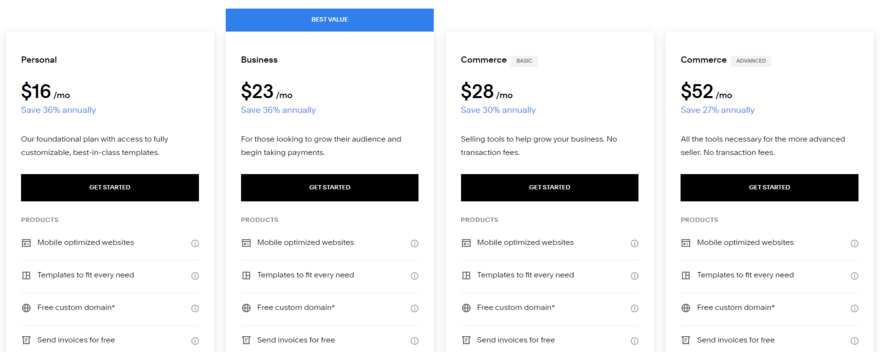
In comparison, Shopify’s pricing will set you back. Its three main plans cost between $29-$299 per month (billed annually), showcasing a steep price increase. On top of that, the cost of additional paid templates, apps, and fees can add up, leaving you with extra expenses to consider.
With that said, Shopify’s high price point is worthwhile if you’re scaling up to sell a high volume of products. All plans come with top sales features like shipping discounts (starting from 77% off on the cheapest plan), localized selling across global markets, and in-person sales.
To give Shopify a spin, you can get your first month for $1 – an inexpensive way to see if it’s the right fit for you. Or, if you need an inexpensive alternative for selling, you can buy the Starter Plan for $5 per month (billed annually) which allows you to sell a few products via your social media accounts.
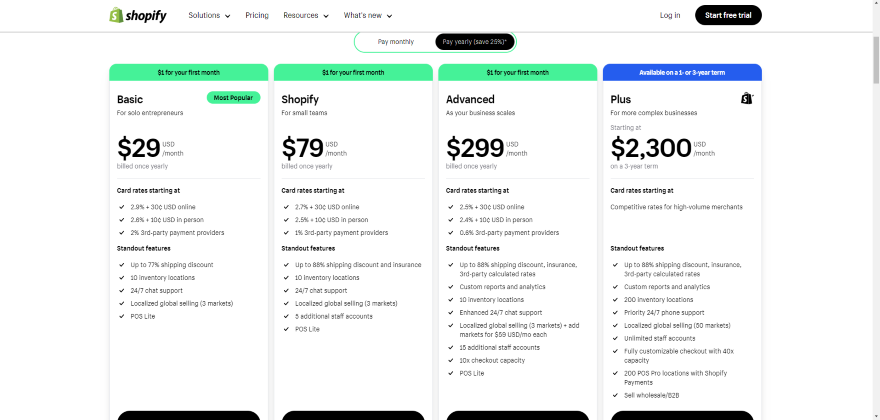
What About Selling Fees?
On Squarespace’s Business Plan, you’ll encounter a 3% transaction fee for each sale. If you’re selling a large volume of products, then this fee will be costly over time, so we recommend upgrading to the Commerce Basic or Commerce Advanced Plan to avoid the fee altogether.
With Shopify, you can avoid transaction fees by signing up to Shopify Payments. It’s easy to sign up to – head to your dashboard, click on payments, and submit the required details about your business.
However, be aware that you can’t escape processing fees if you accept payments online. For instance, if a customer were to make a payment through Mastercard on your Shopify store, then Mastercard would charge you a small fee for processing your transaction.
The Winner
Squarespace is the best value for money
Best for Setting Up: Squarespace
Our research shows that Squarespace is the easiest website builder to use, so we recommend this platform if you need to set up shop fast. The drag-and-drop editor offers an intuitive user experience, while the tools you need are found all in one place.
When we started building an online store with Squarespace, we were impressed by the onboarding process. Before diving into its editor, we could follow a few on-screen tutorials to help us get started. Afterward, we felt confident adding new pages, sections, and product listings to our website.
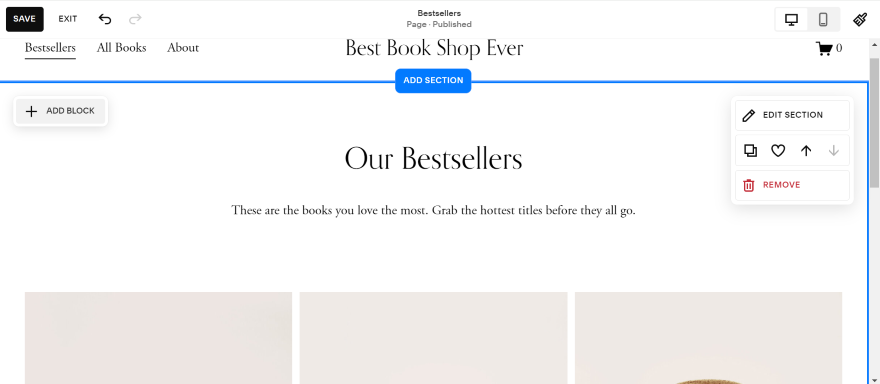
Squarespace might be the easiest builder to pick up, but you also don’t need to be a rocket scientist to get set up with Shopify.
After signing up with Shopify, we had to answer a few key questions on our store before being sent to the dashboard for our tailored setup guide. We appreciated this guide since it gave us a clear idea of exactly what we’d need to do to build our store. Even if you’re a beginner, you won’t feel overwhelmed by this process since everything is broken down for you.
Unlike Squarespace, Shopify encourages you to upload your products first. We noticed that you could import pre-existing products from another website, such as Etsy, or set up inventory syncing if you’re transitioning from a brick-and-mortar store to a digital storefront.
It makes sense that Shopify prioritizes products since it’s primarily a dedicated ecommerce builder. Because of this, we recommend Shopify if you’re uploading a large inventory of goods.
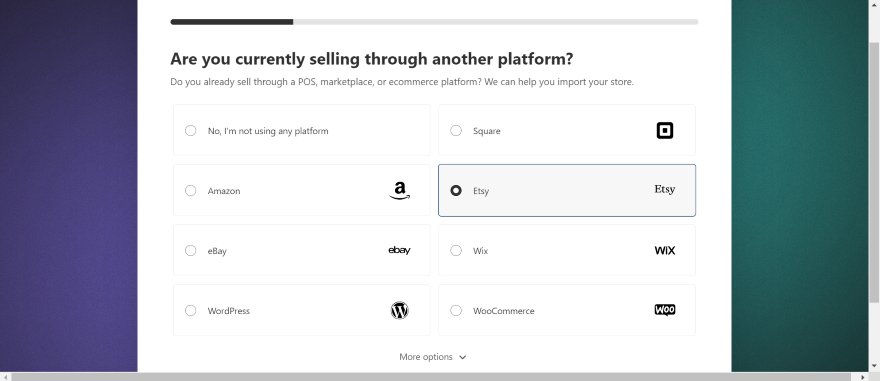
The Winner
Setting up your online store is simple with Squarespace
Best for Ecommerce Templates: Squarespace
For dazzling designs, Squarespace’s templates come out on top. As of writing, the platform has 200+ stylish ecommerce designs in total that are completely free to use.
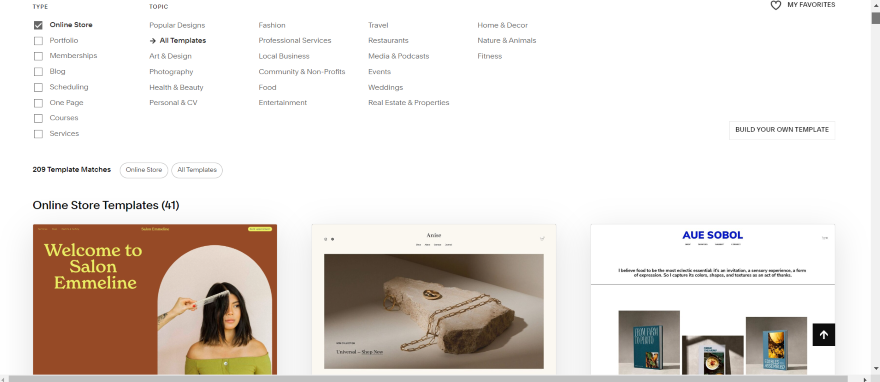
If you need something more specific, you can also use Squarespace Blueprint to design your website. Introduced in 2023, the tool takes you through a five-step process and asks specific questions about your website. Once you’re done, you’ll be left with an original design based on your needs.
The main strength of Squarespace’s templates is how customizable they are. When designing our site, we could change fonts and colors via the site’s style tab and drag-and-drop elements like photos and videos, while the gray grid overlay ensured that everything stayed in place.
If you want more creative control over your online store, Squarespace is your best option. These design features ensure that your brand personality is consistent, so you can keep tweaking your website until you’re happy with its unique look.
Shopify also has professional templates, but they aren’t so impressive. First off, there are only 12 free templates available (at the time of writing), with the rest requiring a one-off payment to use. The best designs will set you back between $140-$400.
Also, Shopify’s templates have fewer customization options. When using Shopify’s editor, we couldn’t find many ways to change our template. Shopify doesn’t have a drag-and-drop editor like Squarespace, so we had limited ways of ordering our sections. The most drastic changes we could make were tweaking our store’s font and color scheme or adding a logo.
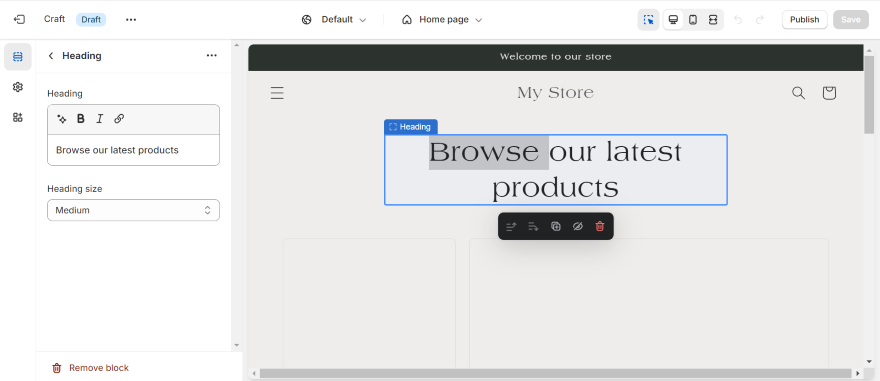
Despite these creative limitations, Shopify’s templates are best optimized for selling. All of the templates included useful ecommerce features. For instance, some have mega menus used to display multiple product categories, or stock counters used to show shoppers when a certain item is almost out of stock.
The Winner
Squarespace’s stunning templates will help you make your website your own
Best for Sales Features: Shopify
Whether you choose Squarespace or Shopify, you’ll have these key sales features at your disposal:
- Unlimited products letting you upload as many products as you need
- Point of Sale (POS) that lets you sell in person – both platforms offer hardware for purchase, an app to manage your sales, and the ability to offer discounts
- Multiple shipping carriers such as DHL Express and USPS give buyers more choice
However, what are the key differences between Squarespace and Shopify’s sales features? Find out below:
Inventory Management
If you need to scale your online store, Shopify’s inventory management tools are the most powerful. In fact, the ecommerce platform comes with these key inventory features:
- Product data that gives you detailed insights into your stock, such as sell-through rates and ABC product analysis
- Up to 2,000 product variations best fit for large inventories (a change featured in Shopify Editions Winter ‘24)
- Inventory filters so you can easily search for specific products
- Inventory movement that can transition between multiple locations

Squarespace’s offering is not too shabby either. Though its inventory management tools aren’t suitable for large inventories, you can access its content manager to organize your products by name, price, and stock levels. This is the most you’ll need if you’re selling a few items here or there.
Payment Options
Whether they’re spending from a digital wallet or putting down a credit card payment, it’s good practice to provide buyers with a variety of payment methods.
Out of the two platforms, Shopify provides the most ways to pay. We found that Shopify offers over 100 payment options, ranging from PayPal and Afterpay to Klarna and Stripe. In comparison, Squarespace fails to keep up with only ten payment options available.

However, both Shopify and Squarespace have native payment solutions designed to keep all payment methods in one place. Though they’re free to set up, you’ll incur processing fees based on the third-party payment providers used, so keep that in mind.
Scheduling
If selling services is your goal, we recommend using Squarespace for Acuity Scheduling. This powerful tool lets you book and manage appointments for your website, helping you set up consultations with clients or classes with students.
Using the tool does come at a cost. You’ll need to purchase a plan first, with prices starting from $16 per month, billed annually. However, all plans come with calendar syncing, video conferencing, and the ability to accept payments and invoices – a worthwhile investment if you intend to set up services online.
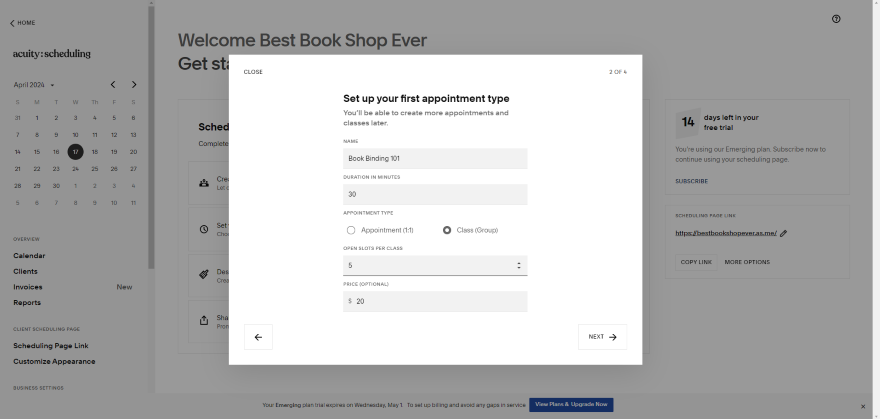
Shopify doesn’t have a built-in scheduling system, so you’ll need an app to add this functionality to your website. You’ll find a mixture of free and paid apps from Shopify’s app store – some five-star scheduling apps include Meety, Appointly, and the Appointment Booking Cowlendar.
The Winner
Shopify is the top choice for powerful sales features
Best for Marketing Features: Shopify
Investing in your marketing efforts is key if you want to grow your online store. Though Shopify and Squarespace offer great marketing tools, there are key differences to consider.
Email Marketing
For professional email marketing, we’d recommend opting for Squarespace. Its email marketing tool lets you create sophisticated campaigns straight from your dashboard and comes with numerous templates to choose from.
When testing out the tool, we noticed that, much like Squarespace’s website editor, it had a drag-and-drop interface that made it easy for us to tweak our design. Adding new elements like photos or buttons was simple, and arranging them on the page was also straightforward.
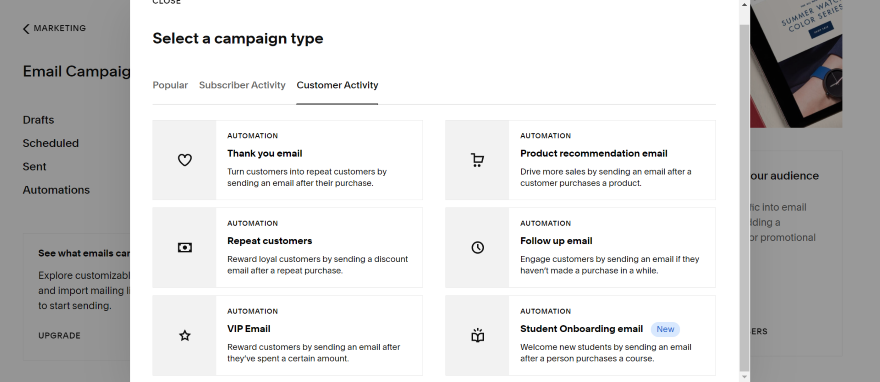
To access the tool, pricing ranges from $5-$48 per month (billed annually) based on the plan you’re on. Each plan comes with sleek templates, a drag-and-drop editor, ways to build your email list, and useful automations.
Shopify also has an email marketing tool, Shopify Email, but we didn’t find it as impressive. When testing, the templates weren’t as visually appealing, and there were fewer ways to customize them. We found different template types to choose from, including newsletters and product highlights, but there wasn’t much variation between each one.
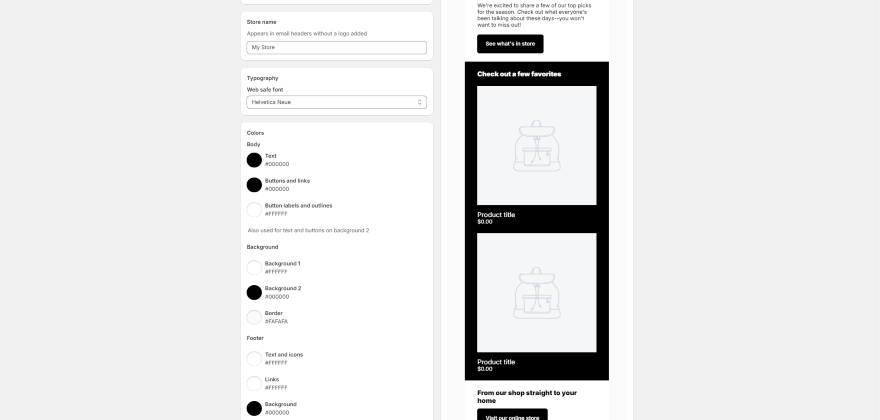
However, Shopify Email will save you some dollars. The Basic, Shopify, Advanced, and Shopify Plus Plans all let you send 10,000 emails for free every calendar month. More than enough to get you started!
Social Media Integration
With 35% of online consumers likely to use social media to make a purchase, it’s wise to invest in your social media strategy.
As it stands, Shopify has the most social media integrations. Thanks to its expansive app store, you’ll find free and paid extensions that allow you to share products across social media platforms. Some of the key integrations we saw include:
- TikTok
Though these apps are free to install, you’ll need to allocate a budget if you’d like to create ad campaigns. For instance, the Facebook & Instagram app will let you set a campaign budget which is then billed to your Facebook ad account.
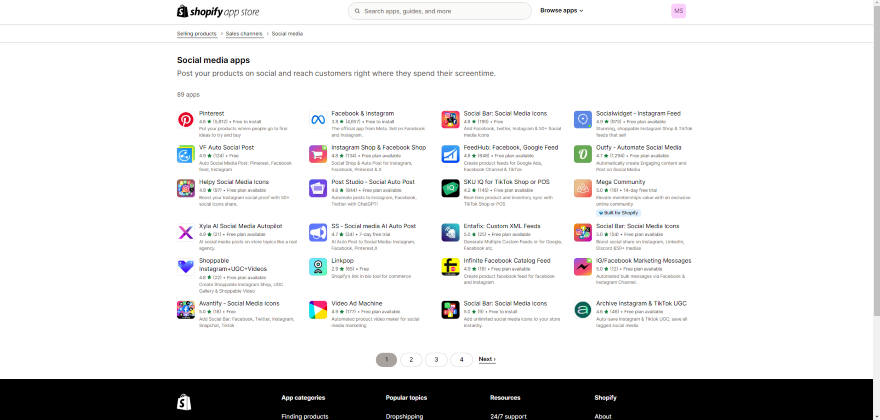
Squarespace’s offering might not be as thorough, but Squarespace does cover key social media platforms such as Facebook, Instagram, and LinkedIn. The editor also comes with built-in social media icons, so you can add them across your website and keep visitors connected.
Search Engine Optimization (SEO)
For maximum visibility on search engines, you cannot ignore SEO. To help people find your products via Google or Bing, you’ll need to pay attention to meta titles, meta tags, product descriptions, and other technical essentials. But does Squarespace or Shopify provide adequate SEO?
Between the two, Shopify has the most comprehensive SEO offering for online stores. Here are the key SEO features it offers:
- Canonical tag generation to prevent duplicate pages on search engines
- Sitemaps that provide Google with key information about your website
- Title tags
- Meta descriptions
- SEO-friendly URLs
- Alternative text that describes what your photos depict, typically to make your website more accessible for visually impaired readers
On top of Shopify’s built-in features, you can also boost your SEO with extensions from the app store. You could download TINY SEO to optimize your photos and speed up page loading speeds, or install Judge.me to improve your SEO through optimized product reviews.

Squarespace’s SEO may lag behind in comparison, but it does provide you with important SEO features like the ability to edit meta titles and descriptions. However, we still recommend Shopify for its SEO which covers all bases.
The Winner
Shopify’s powerful marketing features help your store stand out online
Best for Help and Support: Shopify
If creating an online store is new territory for you, then you’ll need an ecommerce platform with in-depth resources and quick customer response times.
Between Squarespace and Shopify, Shopify’s help and support is the most foolproof. When we encountered a problem with inventory management, there were various steps we could take to find a solution.
For starters, we could ask Shopify’s Virtual Help Center assistant which gave us a speedy response in under 10 seconds. Alternatively, we could ask for human support via phone or email.

Shopify’s Help Center was also useful. Shopify’s resources cover every topic under the sun like domain names, Point of Sale, analytics, website migration, and more. From beginning to end, we felt supported by Shopify.
Squarespace’s help and support does fall short in comparison. Squarespace doesn’t offer phone support if that’s your preferred method of communication, while our research shows that its live chat support (open Monday to Friday, from 4am-7pm EST) has slower response times overall. Despite this, we do recommend Squarespace’s bustling community forums which are home to an active community of users.
Despite having no phone line, Squarespace does offer email and social media contact, as well as its own Help Center that’s well-organized and updated regularly.
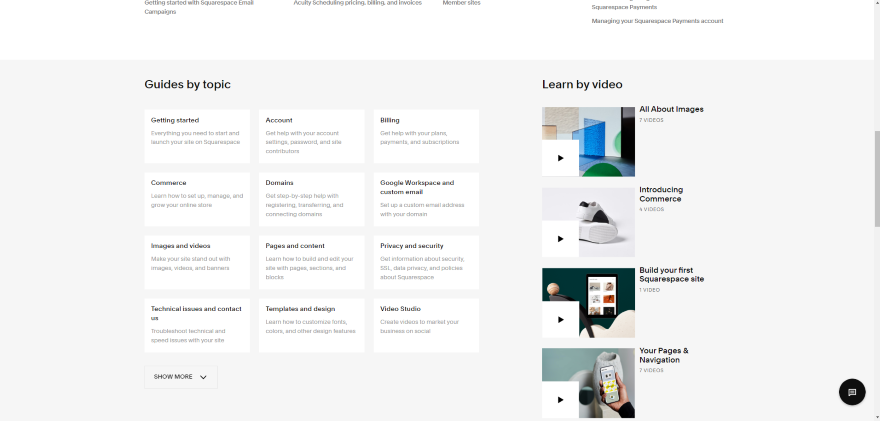
The Winner
Shopify’s help and support covers all bases
Best for Security: Shopify
If customers are buying from you daily, then you must protect them by keeping their customer card data secure. Thankfully, both Shopify and Square implement key website security measures to protect you and your visitors from nasty data breaches:
- PCI compliance is a marker that each platform offers a secure environment for data
- 2-step authentication to stop hackers from gaining access to customer accounts
- SSL certificates ensure your website runs on a secure server – this means sensitive information like credit card details are protected
- Customer login areas create a protected space for website users
The key difference between Shopify and Squarespace is their approach to fraud detection. Shopify offers a myriad of ways to protect users against fraud, most notably through Shopify Payments. If you’re signed up for this free payment solution, you’ll receive in-depth fraud analysis tools that analyze key insights and risk levels for you.
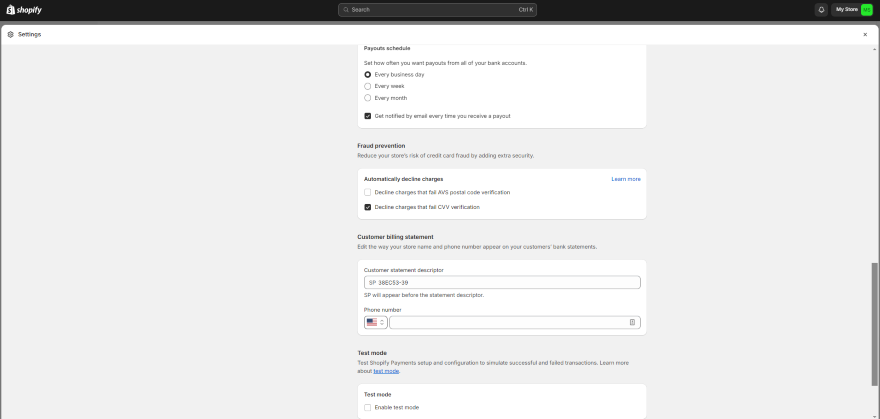
Alternatively, Shopify Flow, the platform’s automation platform, lets you set up automations that spot fraudulent activity for you. For instance, you can use a template to automatically cancel any orders that are marked as high-risk. It’s another great way to protect your user’s data.
Squarespace’s fraud protection measures aren’t so secure. Unlike Shopify, it relies on its third-party payment gateways to pick up on fraudulent transactions. Because Squarespace doesn’t have a built-in system, it’s less likely to pick on threats.
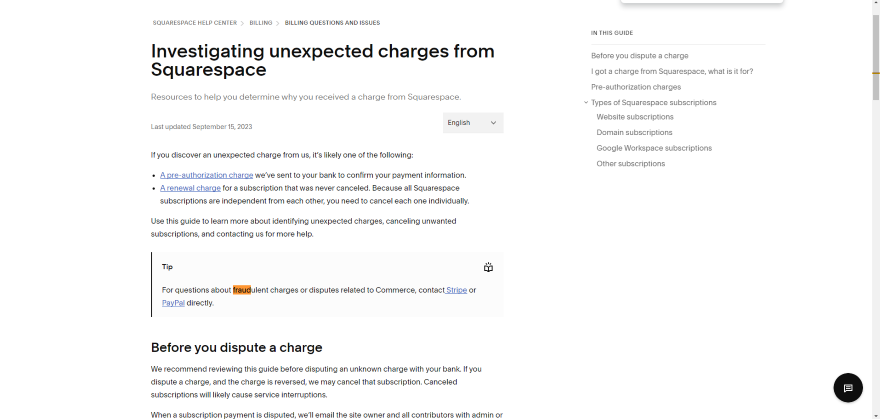
Overall, we recommended Shopify for its top security measures, especially if you’re selling a high volume of products. You’ll want to reassure your users that they can shop without worry.
The Winner
Choose Shopify if you want maximum security for your store
Buying Guide: How To Choose an Ecommerce Platform
Still unsure if Squarespace or Shopify better suits your ecommerce needs? To help you decide, here are some key features to look out for:
Do you want to scale over time? Look for:
- Great product tools that make it easy to manage a large inventory
- Multiple shipping options
- Multiple postage options
- Support for international selling
- Detailed analytics for insights on your website impressions, clicks, and conversions
Are you managing a tight budget? Look for:
- Free templates
- Free apps
- Low transaction costs
- Good value price plans
- A strong number of features per plan
Do you need multiple ways to grow your store’s online presence? Look for:
- Email marketing
- Strong SEO
- Enough social media integrations
- Analytic tools to see where users are visiting your website from
Are you working under strict deadlines? Look for:
- Pre-made templates
- Easy-to-use editor
- Built-in sales and marketing features
- Prompt customer response times
How We Tested Squarespace and Shopify
Curious about our ecommerce website builder research? To provide you with accurate information, our in-house insights team has put Shopify and Squarespace to the test.
Both platforms have been measured in terms of seven key criteria, which are then weighted based on their importance to users:
- Sales Features: 40%
- Website Features: 15%
- Help & Support: 12%
- User Experience: 10%
- Design Functionality: 10%
- Customer Score: 8%
- Value for Money: 5%
For instance, since sales features are important to users looking to sell online, we’ve made sure to cover key features like POS, payment options, and inventory management tools in this article. Thanks to over 200 hours of research, we’re able to provide you with the information you need to make your final decision.
Shopify vs Squarespace: Conclusion
Now that the ecommerce battle is over, we can draw a clear winner: Shopify. Combining high-quality sales features with multichannel selling and strong help and support lines, making an online store has never been easier.
However, this isn’t to say that Squarespace won’t be a good fit for you. If you want your store to have a strong visual identity or are keen to offer services to your users, then it’s well worth considering this platform too.
Need more information before making a decision? Don’t hesitate to read our detailed Shopify review or Squarespace review to get a detailed look at each website builder.


56 comments